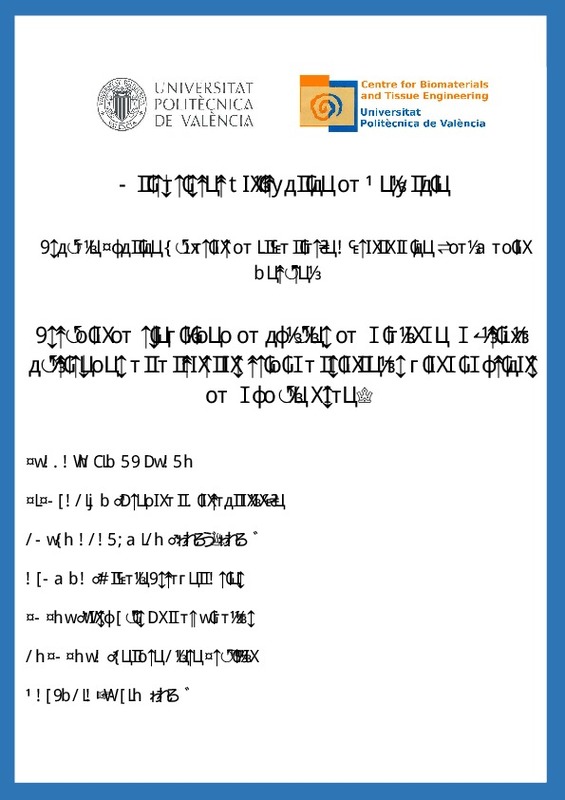|
Resumen:
|
[ES] Actualmente la producción de modelos de médula ósea tridimensionales supone un reto en el
campo de la ingeniería tisular ya que permitiría el avance hacia tratamientos personalizados en
pacientes de mieloma múltiple ...[+]
[ES] Actualmente la producción de modelos de médula ósea tridimensionales supone un reto en el
campo de la ingeniería tisular ya que permitiría el avance hacia tratamientos personalizados en
pacientes de mieloma múltiple y otras enfermedades. En este proyecto se ha desarrollado un
microgel biomimético para reproducir el entorno 3D de la médula ósea in vitro. El objetivo
principal ha sido la obtención del microgel, su funcionalización con biomoléculas de la matriz
extracelular y la evaluación de la biocompatibilidad del sistema propuesto con técnicas de
cultivo celular.
El microgel está formado por microesferas poliméricas de acrilato de etilo, metacrilato de etilo,
dimetilacrilato de etilenglicol y ácido acrílico. Mediante microscopía electrónica de barrido se
han caracterizado las microesferas poliméricas, analizándose su tamaño y morfología. Con el
objetivo de generar una plataforma biomimética para las células de mieloma múltiple, las
microesferas poliméricas han sido funcionalizadas en su superficie con ácido hialurónico,
biomolécula presente de forma natural en la matriz extracelular de la médula ósea. Una vez
injertadas, las microesferas funcionalizadas han sido caracterizadas, mediante técnicas
espectroscópicas, para asegurar la incorporación de ácido hialurónico.
Para evaluar la viabilidad y proliferación celular en el material, se han realizado dos tipos de
ensayos (LIVE/DEAD y cuantificación del DNA) con la línea celular de mieloma múltiple U266,
previamente caracterizada a través de microscopía y citometría de flujo. Con el ensayo
LIVE/DEAD se ha determinado que el microgel es biocompatible ya que no afecta a la viabilidad
celular de forma negativa. Mientras que con la cuantificación del DNA se ha demostrado que las
células proliferan in vitro hasta 6 días de cultivo. Por lo que se ha mantenido la viabilidad y
proliferación celular durante los 6 días de ensayo.
En definitiva, el microgel supone un sistema tridimensional de cultivo in vitro que es capaz de
sostener la viabilidad de las células del mieloma múltiple, la posibilidad de injertar la superficie
de las microesferas componentes específicos de la matriz extracelular, como el ácido hialurónico
abre la puerta a mimetizar las condiciones de la médula ósea. Por ende, se ha conseguido
fabricar un modelo muy prometedor para el estudio de la medicina personalizada en pacientes
de mieloma múltiple.
[-]
[EN] Currently the production of three-dimensional bone marrow models is a challenge in the field
of tissue engineering because would allow the advancement towards personalized treatments
in patients with multiple myeloma ...[+]
[EN] Currently the production of three-dimensional bone marrow models is a challenge in the field
of tissue engineering because would allow the advancement towards personalized treatments
in patients with multiple myeloma and other diseases. In this project a biomimetic microgel has
been developed to reproduce the 3D environment of the bone marrow in vitro. The main
objective has been the obtaining of the microgel, its functionalization with biomolecules of the
extracellular matrix and the evaluation of the biocompatibility of the proposed system with cell
culture techniques.
The microgel is formed by polymeric microspheres of ethyl acrylate, methyl methacrylate,
ethylene glycol dimethylacrylate and acrylic acid. By means of scanning electron microscopy, the
polymeric microspheres have been characterized to analyse their size and morphology. In order
to generate a biomimetic platform for multiple myeloma cells, the polymeric microspheres have
been functionalized on their surface with hyaluronic acid, a biomolecule naturally present in the
extracellular matrix of the bone marrow. Once grafted, the functionalized microspheres have
been characterized, by means of spectroscopic techniques, to ensure the incorporation of
hyaluronic acid.
To evaluate the viability and cell proliferation in the material, two types of tests (LIVE / DEAD
and DNA quantification) were performed with the cell line U266, previously characterized
through microscopy and flow cytometry. With the LIVE / DEAD assay, it has been determined
that the microgel is biocompatible since it does not affect cell viability negatively. While with
the quantification of the DNA it has been demonstrated that the cells proliferate in vitro until 6
days of culture. Therefore, cell viability and proliferation have been maintained during the 6
days of testing.
In short, the microgel involves a three-dimensional system of in vitro culture that is capable of
sustaining the viability of multiple myeloma cells, the possibility of grafting the surface of the
microspheres specific components of the extracellular matrix, as hyaluronic acid opens the door
to mimic the conditions of the bone marrow. Consequently, a promising model for the study of
personalized medicine in patients with multiple myeloma has been produced.
[-]
|





![PDF file [Pdf]](/themes/UPV/images/pdf.png)


